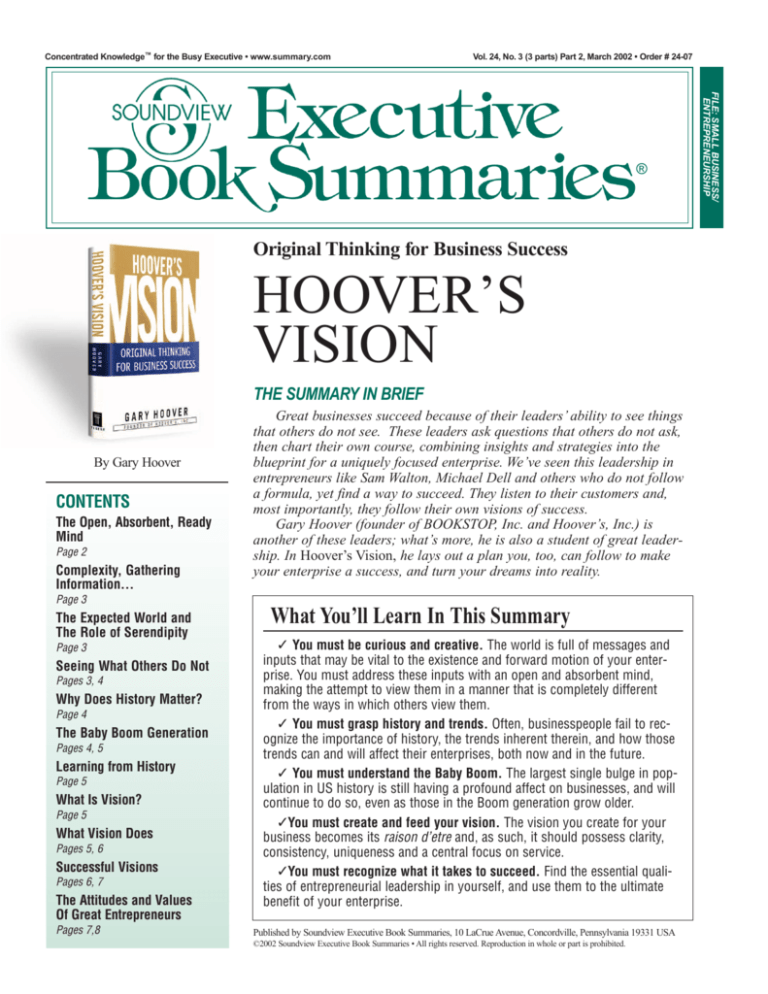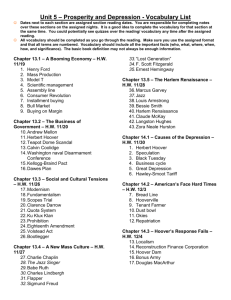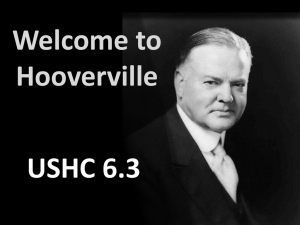
Concentrated Knowledge™ for the Busy Executive • www.summary.com
Vol. 24, No. 3 (3 parts) Part 2, March 2002 • Order # 24-07
Original Thinking for Business Success
HOOVER’S
VISION
THE SUMMARY IN BRIEF
By Gary Hoover
CONTENTS
The Open, Absorbent, Ready
Mind
Page 2
Complexity, Gathering
Information...
Great businesses succeed because of their leaders’ ability to see things
that others do not see. These leaders ask questions that others do not ask,
then chart their own course, combining insights and strategies into the
blueprint for a uniquely focused enterprise. We’ve seen this leadership in
entrepreneurs like Sam Walton, Michael Dell and others who do not follow
a formula, yet find a way to succeed. They listen to their customers and,
most importantly, they follow their own visions of success.
Gary Hoover (founder of BOOKSTOP, Inc. and Hoover’s, Inc.) is
another of these leaders; what’s more, he is also a student of great leadership. In Hoover’s Vision, he lays out a plan you, too, can follow to make
your enterprise a success, and turn your dreams into reality.
Page 3
The Expected World and
The Role of Serendipity
Page 3
Seeing What Others Do Not
Pages 3, 4
Why Does History Matter?
Page 4
The Baby Boom Generation
Pages 4, 5
Learning from History
Page 5
What Is Vision?
Page 5
What Vision Does
Pages 5, 6
Successful Visions
Pages 6, 7
The Attitudes and Values
Of Great Entrepreneurs
Pages 7,8
What You’ll Learn In This Summary
✓ You must be curious and creative. The world is full of messages and
inputs that may be vital to the existence and forward motion of your enterprise. You must address these inputs with an open and absorbent mind,
making the attempt to view them in a manner that is completely different
from the ways in which others view them.
✓ You must grasp history and trends. Often, businesspeople fail to recognize the importance of history, the trends inherent therein, and how those
trends can and will affect their enterprises, both now and in the future.
✓ You must understand the Baby Boom. The largest single bulge in population in US history is still having a profound affect on businesses, and will
continue to do so, even as those in the Boom generation grow older.
✓You must create and feed your vision. The vision you create for your
business becomes its raison d’etre and, as such, it should possess clarity,
consistency, uniqueness and a central focus on service.
✓You must recognize what it takes to succeed. Find the essential qualities of entrepreneurial leadership in yourself, and use them to the ultimate
benefit of your enterprise.
Published by Soundview Executive Book Summaries, 10 LaCrue Avenue, Concordville, Pennsylvania 19331 USA
©2002 Soundview Executive Book Summaries • All rights reserved. Reproduction in whole or part is prohibited.
FILE: SMALL BUSINESS/
ENTREPRENEURSHIP
®
HOOVER’S VISION
by Gary Hoover
— THE COMPLETE SUMMARY
CURIOSITY: THE FOUNDATION OF CREATIVITY
The leader of a successful enterprise is, above all,
curious. He or she lives for knowledge, for an understanding of the world around us and how it works. That
world includes everything from the lines at the supermarket to the aging of the Baby Boom, from the power
of the Internet to the rise of China, from the latest fad
in teenage clothing to the newest technology for creating signs.
Information about the world and its people is all
around us, flooding our senses each day from a thousand directions. The key is to have some idea of how to
make sense of all those inputs. The ways in which the
most innovative, successful people do this include:
● Possessing an open, absorbent, ready mind.
● Understanding complexity, gathering information and asking questions.
● Understanding the expected and the
serendipitous.
● Seeing what others do not. ■
The Open, Absorbent,
Ready Mind
In the daily heat of business, we often say, “Plan the
work and work the plan.” The overall enterprise — in
fact, life itself — is no different. In every building
process, in every construction of a great thing, we must
study before we begin our work.
The most fundamental skill of the curious person is
the ability to look, to observe. Though we all need to
read and absorb books and magazines, the greatest
source of our knowledge is our own eyes and ears in the
real world. Even after we begin to build toward our
goal, we need to keep scanning the world around us,
observing and learning.
To begin to explore and understand the world around
us, we must do the following:
Exercise the mind. We spend enormous amounts of
time, money and energy on making our bodies look
good, but how much time do we spend exercising our
eyes or minds? Like our muscles, the eye and the mind
can be exercised and made stronger with practice.
Exercising the eye and the mind may, in fact, help us
live longer.
Regain a sense of wonder. Nothing escapes the attention of a child. They become absorbed in the things
adults consider commonplace — the world is a landscape without limits, full of wonderful sights, sounds
and ideas. We must regain our childlike sense of wonder, the willingness to be amazed, in order to recognize
the opportunities that lie all around us.
Ponder first, act later. After opening (or reopening)
our minds to wonder, we must then allow ourselves to
ponder — to think before we speak, act or (most importantly) conclude. We must cultivate the skills of contemplation, and not confuse contemplation with indecision:
There is a time to think and a time to act.
Get into the information flow. We are at our best
when information flows through us, enabling our minds
to really get around a subject. If your ideas flow —
through your pen to a page, out your mouth over the
phone or in conversation — they will become more
vivid, more practiced, more tested.
The more we think about our ideas, communicate
them to others and receive feedback on them, the
stronger those ideas become. Information is a unique
commodity — we can give it away and not only still
possess it, but actually come out ahead. We are at our
strongest when we are always learning and, simultaneously, sharing what we know. ■
For more information on exercising the mind to live longer, go to:
http://my.summary.com
The author: Gary Hoover was a retail security analyst
on Wall Street and manager of strategic planning for May
Department Stores before founding BOOKSTOP, now
part of Barnes and Noble. Hoover is also the founder of
Hoover’s Inc., the company behind Hoover’s Online.
Copyright© 2001 by Gary E. Hoover. Summarized by
permission of the publisher, Texere, 55 East 52nd Street,
New York, NY 10055. 348 pages. $26.95. 1-58799-059-8.
For more information on the author, go to:
http://my.summary.com
Published by Soundview Executive Book Summaries (ISSN 0747-2196), 10 LaCrue Avenue, Concordville, PA 19331 USA, a division of Concentrated
Knowledge Corporation. Publisher, George Y. Clement. V. P. Publications, Maureen L. Solon. Editor-in-Chief, Christopher G. Murray. Published monthly.
Subscriptions: $195 per year in U.S., Canada & Mexico, and $275 to all other countries. Periodicals postage paid at Concordville, PA and additional offices.
Postmaster: Send address changes to Soundview, 10 LaCrue Avenue, Concordville, PA 19331. Copyright © 2002 by Soundview Executive Book Summaries.
Available formats: Summaries are available in print, audio and electronic formats. To subscribe, call us at 1-800-521-1227 (1-610-558-9495 outside U.S. &
Canada), or order on the Internet at www.summary.com. Multiple-subscription discounts and Corporate Site Licenses are also available.
2
Soundview Executive Book Summaries ®
Hoover’s Vision — SUMMARY
Complexity, Gathering
Information, and Asking
Questions
Once our mind is open and ready to receive, we can
begin to absorb information. Sometimes, however, the
world is difficult to figure out, and we tend to accept
simple explanations for things that are actually quite
complex. The first task of a thinking person is to separate what is meaningful from what is meaningless.
What You Should Know
Many people are scared of the prospect of information
overload; they have trouble keeping an avalanche of
information from crashing their brains. They forget that
knowing everything is not the key; the key is to:
1. Know what matters. Rise above the clutter.
2. Know how it ties together. Create a structure on
which you can hang new information and link it to
information you already have.
3. Know where to look for information — how to
research and learn more.
4. Know how to analyze information.
5. Know how this information relates to your job,
project or personal goals.
Of course, there’s no better way to draw information
into our minds than to ask questions, starting with the
good, old-fashioned “who,” “what,” “where,” “when,”
“why,” and “how.” Asking questions enables you to
establish your context in the world; the more you understand your context, the more successful you’ll be. ■
The Expected World and the
Role of Serendipity
In order to creatively explore the world around us and
the opportunities it holds, we must first open our eyes
and minds to those opportunities; we must ditch our
expectations and see what others do not see.
Even the most creative people get stuck in a rut, following a comfortable routine so closely they stop being
creative in the broadest sense of the word. If, however,
we occasionally take a step sideways, if we take the path
less traveled five percent of the time, if we at least glance
around us as we make our way through life, then we have
a dramatically improved shot at making breakthroughs,
discovering great things, turning dreams into reality.
In your search for answers, the answer is almost never
where you expect it to be, or where you are looking for
it. History books and company profiles are full of stories of accidental discoveries that gave rise to great
innovations. In the early 1950s, for example, George de
“You Never Get Anywhere
Going the Obvious Way”
Charles Kettering, the noted engineer and inventor,
started a company called Dayton Engineering
Laboratories Company (DELCO) in his hometown of
Dayton, Ohio, then sold it to General Motors. His new
boss, Alfred Sloan, made him head of science at GM
and wanted him to move to an office in Detroit.
Kettering wouldn’t move, so every week he drove US
Highway 25 between Dayton and Detroit. Others who
drove the same stretch marveled at how Kettering
made the trip hours faster than they did.
When asked how he did it, Kettering admitted that
he detoured around small towns. He spent most of
his time on country roads, not the main road. “You
never get anywhere going the obvious way,” he noted.
Mestral went for a walk in the Swiss woods and came
home with burrs in his socks. He invented Velcro. Pierre
Omidyar’s fiancée collected and traded Pez candy dispensers; this led him to start a Web site called Auction
Web, which eventually morphed into eBay.
Today’s automated dictionaries let us look up a word
like scone without wasting time on other words. But
flipping pages in a traditional dictionary might also lead
us to discover the meanings of sclaff (to strike the
ground with a golf club before hitting the ball) or
sconce (a decorative wall bracket for candles). If we
allow our minds to operate on cruise control all the
time, there is much around us that we will miss. ■
For a story on how the author looked for the unexpected, go to:
http://my.summary.com
Seeing What Others Do Not
As we consume information, we must cultivate a
healthy skepticism, refusing to trust or believe something
simply because it is documented in a newspaper, magazine or book. Take a few seconds to compare what you
hear with what you know; look behind the headlines to
determine how much of a story is spin, opinion, conjecture and/or hard fact. We cannot delegate our responsibility to understand — even to the finest and most accurate
journalists, interpreters, commentators or experts.
It’s not enough to simply look behind the headlines —
you need to look where there are no headlines, where other
people aren’t looking. Headlines, whether on target or off,
direct your attention to what everybody else is thinking
Soundview Executive Book Summaries ®
(continued on page 4)
3
Hoover’s Vision — SUMMARY
Seeing What Others Do Not
(continued from page 3)
about. To gain a broader perspective of the world, spend
time looking at things no one else seems concerned with,
thinking in ways other people are not thinking.
Break Out of Familiar Patterns
Indeed, unconventional thinking should be applied to
every area of your business. Find lessons in other industries that you can transplant to your own. Break out of
your own familiar patterns in order to gain fresh insights.
If you’ve budgeted 6.9 percent of sales for customer
service for the past five years, it’s not hard to imagine
going to 6.6 percent or 7.2 percent (a phenomenon Jack
Welch of General Electric calls “pushing the peanut”).
Would you ever consider the impact to your business of
slashing service spending to 3 percent, or pumping it up
to 12 percent? Really good ruts are so powerful, we
don’t even know we’re in them.
Even people with opposing points of view are often
locked into the same perspective. General Motors and
Ford might have better management techniques, but
DaimlerChrysler makes better-looking cars. IBM and
Unisys battled for years over the large mainframe market, while Bill Gates and Steve Jobs were talking another language. If you can get out of the channel everyone
else is in and look at things from a different angle, you
can often gain fresh insights. ■
HISTORY AND TRENDS: THE STUDY OF CHANGE THROUGH TIME
Why Does History Matter?
Once our curiosity is in place, how do we use it?
What do we pay attention to?
While we tend to focus our attention on the here and
now, we often fail to ask ourselves what came before, or
how things change through time. One of the most common causes of failure is the inability of leaders to see the
most important underlying trends — trends that emerge
from the past to create the present and shape the future.
Whether a trend is large and slow moving (like the
introduction of women into the workforce, which happened at an almost glacial pace) or more localized and
fast-paced (such as business trends contained within a
specific market), missing the onset and impact of trends
can spell the end of your enterprise. Alert observers, on
the other hand, create new fortunes by seeing where
things are going, by recognizing trends at work more
quickly than the competition.
The great leader watches trends to see things that others do not, to seize opportunities where others only see
confusion. ■
The Biggest Trend:
The Baby Boom Generation
The single most important trend for most of us, particularly in the United States, is the aging of the Baby
Boom generation.
The years in which the members of the Baby Boom
— the largest single bulge in population in US history,
consisting of roughly 107.5 million people — will reach
particular stages in life are precisely predictable. And
history shows that people do many important things at
predictable points in their lives (see box next page). In
the trends that emerge from these predictable actions lie
4
major opportunities for enterprises both old and new,
both for-profit and non-profit.
Non-demographic Factors to Consider
For most enterprises, there is no single factor as
important as the demographics of the customer and how
they are changing over time. There are, however, other
factors at work, and to ignore them would be a mistake.
For the Baby Boom generation, those factors include
the following:
The aging of the Baby Boom is not a single-point
trend. The fact that the Baby Boom is not a one-year or
localized phenomenon means you must interpret its
influence with care, even though that influence is enormous. Trends that in prior generations might have
occurred in a more compact period of time (first-time
marriages, for instance) will likely be elongated, due to
the extended length of time of the Baby Boom bulge.
Age-related trends do not necessarily correspond
with generational trends. For every age-related trend,
you must determine to what degree the trend reflects
temporary shifts in need or taste, as opposed to patterns
in consumption that will stay with the generation for the
remainder of their lives.
Historical age-related consumption patterns can
change. The shape of demand for products and services
historically shifts as the consumers of those products and
services get older. The sheer size of the aging Baby Boom
generation may change some of our basic assumptions
about these trends — they will be healthier and live
longer; demand education later in life; and maintain more
varied interests than senior citizens of prior generations.
You will likely have to adjust your enterprise’s assumptions about this aging group to meet these new trends.
The aging of the Baby Boom is a phenomenon of the
Soundview Executive Book Summaries ®
(continued on page 5)
Hoover’s Vision — SUMMARY
What Changes as We Age?
While any individual might not fit the particular
mold, here are some general conclusions that hold
true when you aggregate a large number of people,
like the 107.5 million that comprise the Baby Boom
generation:
✓ They complete formal schooling in their
teens and twenties.
✓ They get their first jobs in their teens and
twenties.
✓ They get married and have their first child
in their twenties and thirties.
✓ They spend heavily on consumer items in
their thirties and forties.
✓ They steadily increase their skills and job
productivity until their fifties.
✓ They achieve their greatest wealth in their
fifties and sixties.
✓ They begin to retire in their fifties, peaking
in their sixties.
✓ They give away more money in their sixties
and beyond.
✓ They gradually increase political participation (especially voting) from a very low
level in their twenties to a peak in their
seventies and eighties.
✓ They die in their seventies and eighties,
supporting enterprises even until their last
breath.
The Biggest Trend: The Baby Boom Generation
(continued from page 4)
developed world. While the post-World War II population
bulge can be seen in the US, Japan, Canada, Australia
and other locations, it cannot be seen in many countries
around the world. As business becomes increasingly
global, you must know the population and age structure
of any nation in which you do business, and you must
think about how that structure will change, and how your
business must change with it. ■
For further reading on the impact of the baby boom, go to:
http://my.summary.com
Learning from History
Here are some practical things you can do to use history and trends to better your enterprise:
● Look around in your organization or industry for
the person who knows its history. Get as much information from them as you can, using them as a resource for
your own growth.
● Look at old copies of Fortune magazine, scouring
each issue for at least one great but forgotten business
idea. Figure out how this idea can be recycled in a new
form for today’s business world.
● Find out which companies were the largest in your
industry thirty years ago, and compare them with the
largest companies in the industry today. What happened
to those that faded? How did the new leaders rise to
prominence? Are there lessons that can be learned from
the leaders of the past? ■
ESSENCE: THE POWER OF VISION
What Is Vision?
When you have vision, you have an informed and forward-thinking statement of purpose that guides you in
all you do. Your vision tells you why an enterprise
exists; without a clear purpose, an enterprise is a ship
without a rudder, a train without a track.
A vision should also be informed, fed by your understanding of the world, reflecting the trends at work in
your environment. Hand-in-hand with being informed
comes “forward thinking,” reflecting what you expect
and hope your organization will become — a statement
of ambition that informs everyone of the direction of the
enterprise. All priorities flow from a clear vision.
There is no “standard” or formula for creating a
vision — it should be highly customized, something
that could only come from your enterprise. It also
should reflect your core values, in the very broadest
sense of the term. A good example of this is the Cross
Pen Company. Cross does not compete with Bic and
Papermate for the ballpoint writing instrument business;
it competes with briefcases and paperweights for the
corporate gift business. Regardless of whether Cross
wrote this down in fancy mission statements, the company has a real story, a distinct message that defines its
enterprise and sets it apart. Every great enterprise has
such a message. ■
What Vision Does
Some might argue about the importance of vision, not
realizing that their companies are guided by vision even
though it might not be an overt part of their corporate
strategy or philosophy. Regardless of whether you “do
vision” consciously, here are the reasons it is so useful
in achieving your organization’s goals:
Soundview Executive Book Summaries ®
5
Hoover’s Vision — SUMMARY
What Vision Does
(continued from page 5)
A vision bonds. Diversity is a much-sought-after
commodity in business, particularly in larger companies. You can bring together people of diverse races,
religions, ages and lifestyles for a common, shared purpose: the vision that guides your enterprise.
● A vision inspires. People are more motivated if
they believe they are doing something worthwhile, if the
believe that they can — through participation in the
enterprise — accomplish something that is worthy of
their time and energy. A clear vision offers a sense of
purpose that can be a continual motivator and force of
inspiration in even the largest of organizations.
● A vision is an anchor in hard times of change.
Those organizations that understand themselves, that
have a clear vision and are true to it, have much more
confidence and far fewer doubts than an organization
without such a rudder.
● A vision is a potent competitive tool. You can use
your vision to differentiate your enterprise from your
competitors, and even to trounce them, particularly if
they do not have a clear and consistent definition of
themselves.
● A vision builds community. Once you have articulated your vision and are confident in it, it is important
that it reaches and motivates not only your employees but
everyone who touches the enterprise — including customers, auditors, ad agencies, and so forth. A great vision
turns your enterprise’s acquaintances into advocates. ■
●
Characteristics of
Successful Vision
There are four primary attributes or dimensions in
successful enterprise visions — in essence, four pillars
on which the enterprise is built. While some companies
succeed with only two or three of these in place, truly
great enterprises must have visions that are clear, consistent, unique and serving.
The Clear Vision
It is impossible to overvalue the contribution of a
clear, simple vision, articulated in terms that are free of
corporate doublespeak (no mention of “rightsizing,”
“reengineering,” “paradigm shifts,” and the like) and
industry jargon or acronyms (no mention of “ISO,”
“TQM,” “RFPs,” and so forth). When we are scared or
uncertain, when we think we have to impress someone,
we often resort to “unclarity.” Such endeavors are often
just confusing, and can be counterproductive.
In many fast-growing companies, as many as half the
6
Southwest Airlines — Clarity and
a “Third Grade Vision”
Much has been written about Southwest Airlines
and its unique style of doing business, but what is
possibly most impressive is the simplicity and crystal
clarity of the company’s message. Since the company’s founding 30 years ago, Southwest has held to a
handful of key beliefs.
First, it flies one type of aircraft (the Boeing 737),
so that all its crews are trained on the entire fleet, and
to reduce the organization’s investment in spare parts.
It maintains an efficient, no-frills operation — the
flight lands, the first people to arrive receive the first
(classless) seats on the plane, passengers get
peanuts instead of a meal, and the plane takes off.
Finally, Southwest has a unique culture that stresses fun as an important corporate quality.
These simple ideas — expressed openly in terms
that any third-grader could understand, not to mention every flight attendant, baggage handler, marketer
and executive as well — have contributed to the airline’s success as the most consistently profitable
company in its industry.
organization’s employees may be new hires. If a growing company indoctrinates its people in an entirely new
language, the newcomers either must go around asking
what all these strange words mean, or simply stay in the
dark and feel stupid. A wall is built between the newcomers and the old-timers. This is no way to bond
together an organization.
The English language is beautiful and powerful.
While it is hard to keep from using buzzwords and jargon, it is worth the perpetual struggle to keep our words
— and our mind — free from such things, for the good
of the enterprise and our vision.
The Consistent Vision
In this era of rapid, even accelerating change, it can be
difficult to know which way to head. Different factions,
including venture capitalists, Wall Street, stockholders
and even your own Board of Directors, will give you
conflicting views, particularly when success is uncertain.
If you study great, lasting enterprises, however, the
evidence overwhelmingly supports staying the course. If
your course is based on a sound idea and your direction
reflects what you know about people, trends and geography, that course should serve you well over time. Your
confidence in your vision comes from knowing what
matters — knowing what you are good at and what is
Soundview Executive Book Summaries ®
(continued on page 7)
Hoover’s Vision — SUMMARY
Characteristics of Successful Vision
(continued from page 6)
important to you, and sticking to your vision through
bad and good periods.
After Walt Disney and his brother Roy (the dealmaker and bean-counter in the family) both died, the
Walt Disney company began to slide. The reason: The
focus of the organization’s leadership shifted from being
the world’s greatest maker of family entertainment to
simply being a company that turned a profit. It wasn’t
until leadership changed (and two visionaries —
Michael Eisner and Frank Wells — were put in charge)
that Disney refocused its energies on its core values.
Once they did, the company went from making bombs
like Tron, to turning out successful nouveau classics like
The Lion King and Toy Story, recovering their audience
and profits as a result.
The Unique Vision
The successful vision is a unique vision; if you try to
accomplish the exact same goal as another organization,
it is not likely that both companies will be successful. If
you are starting a new company, it is critical that you
find your own space or niche in the world. The most
successful enterprises do one thing, and do it very well.
Part of the reason enterprises must have a unique
vision is that they will be most successful if they strive
to be the best at something, or the best or biggest in
some regard. Some ways to differentiate your enterprise
include the following:
● Finding gaps in a competitor. For years, Toys “R”
Us never had a successful toy store competitor, although
chain after chain tried to copy them. It occurred to the
author that someone could build a chain, if they simply
got the business of everyone that Toys “R” Us has
upset. It is not that Toys “R” Us is a bad or customerunfriendly company, but every company has an Achilles
heel, a weakness that competitors can exploit to find
their own success.
● Pursuing “Class B” ideas. Sometimes, an idea that
is not completely sound (a “Class B” idea), but which is
executed with passion and intensity, will beat out a
great idea (a “Class A”) that is executed half-heartedly.
Of course, it’s hard to beat a Class A idea pursued with
total intensity (Microsoft, for example).
● Seeing the world in a different way. Volvo has
never in its history sold a car; instead, it sells durability
and safety. It built its own uniquely defined niche, setting it apart from the Fords and Toyotas, and maximizing the potential of its brand.
A Vision Built to Serve
Saying an enterprise exists to make a profit is like saying automobiles exist to get good gas mileage. The only
valid reason to the existence of any enterprise — for
profit or nonprofit — is to provide products or services
to people. Enterprises that forget this will perish; those
that remember that fact and put it into practice every day
have a chance at long-term survival, even prosperity.
It is virtually impossible to overstate the power of the
customer. The US Post Office long held a monopoly on
home deliveries and, on many occasions, made such
deliveries difficult for customers (forcing them to go to
the post office to pick up packages, or insisting customers be home at exactly the right time, etc.). The customer was not being well served, and Federal Express
and UPS filled that gap. The only rule is that customers
always get what they want; it’s just a matter of who
gives it to them and when.
“Service First” means “Other Things Second.” While
nearly every company gives lip service to the importance of the customer, most companies make their decisions based solely on accounting terms. The enterprises
that survive and prosper the longest, however, always
start by asking, “What is best for our customers?” ■
THE RIGHT STUFF: WHAT IT TAKES TO SUCCEED
The Attitude and Values
Of Great Entrepreneurs
What does it take to create and sustain a successful
enterprise? Consider your role, as well as the roles that
others have played in past enterprises. You’ll find that
the attitudes and values shared by entrepreneurs who
build great enterprises include the following:
● Passion. One of the greatest tragedies in our world
is all the people who hate their work, or merely tolerate
it. If you don’t love what you do, you’ll never go the
extra mile, work the extra hour, or dream up the new
idea. If you are doing something you love — if you
have your heart in it — you will have a chance to excel.
Whether you’re planning the course of your life or planning what merchandise to display at your corner store,
there is always a winning place for passion.
● Persistence. From passion flows other qualities, all
of which lend strength to your enterprise and increase
its chances for success. Persistence — the endurance to
continue the journey — is one of these qualities. Most
enterprises begin with one person starting out alone;
eventually, that person will find another who believes in
Soundview Executive Book Summaries ®
(continued on page 8)
7
Hoover’s Vision — SUMMARY
The Attitude and Values of
Great Entrepreneurs
What Entrepreneurs Believe
(continued from page 6)
the vision of the enterprise, then another, then another.
If you are persistent enough, eventually the whole world
will believe in your vision. It’s a long road to get to that
level, and there are many obstacles to overcome, but the
ability to persevere and overcome those obstacles is one
of the most common patterns you see in the building of
great enterprises.
● Energy. Truly successful entrepreneurs are an
intense group of people, with a high level of energy and
a fire burning inside them to succeed.
● Self-confidence. Many parents tell their kids, “You
can do anything you put your mind to.” Entrepreneurs
are the kids who believed them. Self-confidence is not,
however, a simple quality; it refers to a combination of
courage, optimism, self-esteem and self-reliance.
Entrepreneurs must also be hopeful — about themselves, their enterprises, and the industries in which they
exist. They must not be blind to problems around them;
rather, they must see those problems as opportunities
for innovation.
Profiles in Persistence
Accomplishing anything worth accomplishing
takes enormous endurance. Consider the following:
As of the end of 1998, Wayne Newton had given
26,000 live performances in Las Vegas, not counting
TV appearances and concert tours. He had also made
142 albums. Regardless of what you think of his
music, you must recognize his energy and
endurance.
When Steve Case took AOL public in the early
1990s, his own stock was worth less than $1 million,
and he had been working at it for seven years. Most
“experts” thought that AOL would perish, that its
business model was not sustainable. Years later,
Case might have been the only person on earth who
wasn’t shocked when his company acquired Time
Warner.
When Carnival Cruise Lines first started, the company couldn’t afford a new ship, so they bought an
old, slow, beat-up one; their cruises, consequently,
took longer than their competitors’ to reach the same
destinations. Instead of giving up, Carnival added
discos and other amenities to keep their passengers
entertained while on board. By doing so, the company reinvented and reinvigorated the cruise industry,
and today it holds a market share in excess of 50
percent.
8
Entrepreneurs and leaders who think like entrepreneurs believe the following:
✓ We can do anything.
✓ We can learn anything.
✓ We can make this world a better place.
✓ We can make a difference.
✓ We can figure it out.
✓ We can lick the toughest problem.
✓ Few things (if any) are outside of our control.
✓ No competitor scares us.
✓ We will focus on what matters.
When pundits and so-called “experts” try to give
you direction that runs counter to your vision and the
expectations of your ultimate bosses (those who buy
your products and services), don’t listen to them.
Listen to yourself and your customers.
● Action
orientation. The most successful entrepreneurs are passionate, visionary, driven people who are
never content to merely sit around. They want to do
things, to learn, to experiment. If they fail, that’s fine —
failure is an expected part of the process. Rather than
sitting around waiting for or planning a giant effort,
they are willing to move ahead, step by small step, making constant progress. The only thing they can’t stand is
inaction.
● Individuality. Entrepreneurs are, above all else,
true to themselves; they are also as individually unique
as any group of people you could meet. They all have
their own underlying personal goals, and each entrepreneur is unique in his or her breadth of vision; whether
that vision is broad or narrow is dependent upon the
particular outlook of the entrepreneur in question.
● Entrepreneurial leadership. Entrepreneurial passion is translated throughout the entire enterprise
through one quality: leadership.
Do not confuse leadership with management,
although both are needed by any lasting enterprise.
Management is a world of budgets, of hiring and firing,
of dealmakers, lawyers and accountants. Leadership, by
contrast, is a world of passion and vision, of seeing
what needs to be done and having the courage to do it.
Management is about knowing how to fit together the
details to make the vision real. The leader is the one
who shows the way, who holds up the torch to the
future so it is clear for all to see. From the leader’s passion, the whole organization draws strength. ■
Soundview Executive Book Summaries ®








